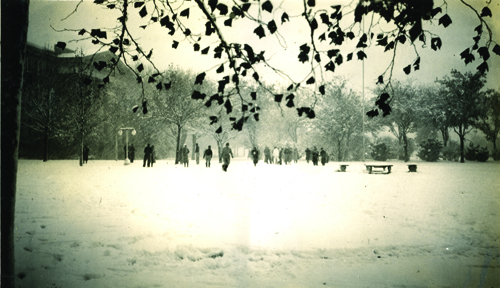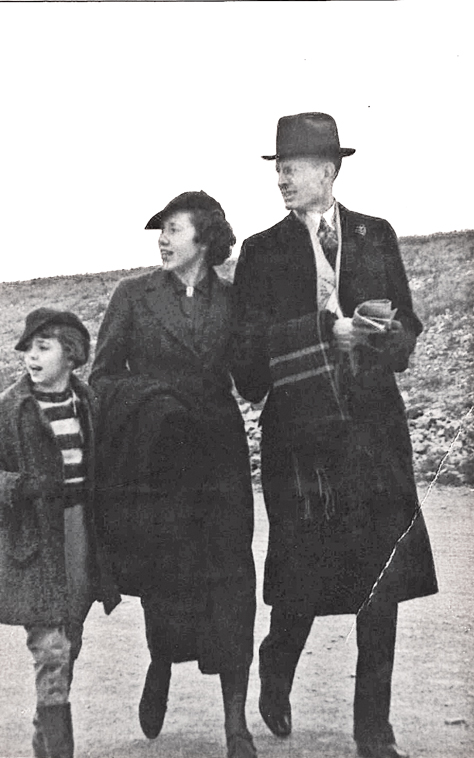
From the photo album
Recollections of the 1938 National Champion Horned Frogs bring back a flood of memories -- and a peek into the past.

By Marjori G. Sharp ’39
"How I have enjoyed my Fall 2008 The TCU Magazine! Especially the last two pages [Recollections of the 1938 National Championship]. It sent me right to my old photo album. That was my senior year at TCU and two of my best buddies were Davey O’Brien ’39 and I.B. Hale ’39, who I had known in high school.
 These pictures show what we did to get a school holiday after a football game victory -- we closed the doors to the Ad Building, where most of our classes were held. Do the students still do that sort of thing? These pictures show what we did to get a school holiday after a football game victory -- we closed the doors to the Ad Building, where most of our classes were held. Do the students still do that sort of thing?
The car, a relic even then, belonged to Bud Taylor ’33, one of my favorite football players and the boyfriend of one of my friends, Chris Yaggy. By the way, we called it "Texas Courtin’ University."
I wish I could name all the people in all the pictures -- I can begin, but I can’t get very far.
I think the magazine is fantastic. I have three children, and not one of them has the feeling for their alma mater that I still have for TCU, and I think a lot of it has to do with how the school has kept my love and loyalty all these years by staying in touch with such wonderful periodicals. Keep up the good work!"
That’s Marjori, circled in the photos above and to the right. We were so charmed by her letter and photos, we had to find out more. So we asked:
Why was TCU called Texas Courtin’ University?
"Most everybody met someone they were crazy about. I didn’t, but everybody else did. My husband went to Texas A&M and we met through a mutual friend."
Did you and your classmates really lift a car up onto the steps of the Ad Building steps to get out of class?
"Yes, and we also barricaded the other entrance. It worked! I seem to remember the professors took it in good humor. We wanted a holiday after winning the 1938 national championship (capping an 11-0-0 season by winning the Sugar Bowl.)"
You lived in Jarvis your junior year – what was dorm life then?
"I loved Jarvis. We were on the third floor in a corner room. My roommate and I would sit and watch everybody’s coming and goings."
What do you think of TCU today compared to when you were a student?
"It’s so much more colorful now with all the plants and flowers everywhere. It’s still a very special place."


Full court press
Blackie and his boys, together again
By Mark Mourer ’95 (MS ’04)
They claimed to write for each other, knowing that at least their "ownselves" would appreciate the literary references, dry wit and innuendoes in the prose. They also wrote, as Gary Cartwright ’57 often said, "under the assumption that nobody would read what we wrote anyway."
The latter could not have been further from the truth. However, Cartwright’s insight provided humorous explanation for the adventures that the Blackie Sherrod-led Fort Worth Press staff of the 1950s would turn into journalistic legend.
Nearly everyone over the last five decades has read or been touched by what Cartwright, Sherrod, Dan Jenkins ’53, Edwin "Bud" Shrake ’54, Jerre Todd ’57 and Julian Read ’57 wrote throughout their careers. And it all started on the fourth floor of a dilapidated building on Jones Street that no longer exists.
The Press itself stopped printing over 35 years ago, but by then Jenkins had moved on to Sports Illustrated, Sherrod to the Dallas Times-Herald and eventually The Dallas Morning News, Todd and Read to successful advertising and public relations careers and Shrake and Cartwright to nationally acclaimed writing status.
They convened in Dallas this September to connect and do what they have done better than just about anyone for the last 50 years: tell stories.
Shrake authored, among screenplays and best-sellers, one of the top-selling sports book of all time, Harvey Penick’s Little Red Book.
Read went on to be the founder, chairman and CEO of the public relations firm GCI Read-Poland in Austin. Jenkins has written best-selling novels, including Semi-Tough, for over 30 years while also writing for Golf Digest.
Todd ran a successful advertising company that his son operates today in Arlington.
Cartwright, who has written for Harper’s, Life and Esquire, currently is on staff at Texas Monthly and has written several books and screenplays.
At the reunion, Read, who was the last of the five to be inducted into the Schieffer School of Journalism Hall of Excellence Hall in October, acknowledged Cartwright’s description of the staff’s approach to writing at the Press, but also offered a big-picture assessment -- assembled under Blackie, the Press staff would achieve greater success per capita than most newspapers would have had working under one roof at one time. It never occurred to "Blackie’s Boys" that there was any less talent anywhere else, nor would it be evident until they went on to pursue their individual goals in the late ’50s.
"We all just assumed that everyone (in journalism) could write," Read said, adding that, in retrospect, they "had the talent there to publish The New York Times."


The "first" Tomlinsons
They weren't football stars but they had a major impact on TCU.
Long before LaDainian ‘05 stepped on campus, the Tomlinson name was synonmous at TCU with philanthrophy and leadership -- and a residence hall in Worth Hills. This historic photo is courtesy of Susan Carol Davis ’77. She writes:
The photo is of my grandfather, Clyde Tomlinson ’16, age 39, my mother Peggy Tomlinson Davis ’72, age 9, and my aunt Mary Carl Tomlinson Barbisch, age 18, in 1935, going to watch the legendary Sammy Baugh play in the TCU vs. Rice football game on campus. Clyde Tomlinson and my grandmother, Harriet Smith Tomlinson ’14, both graduated from TCU in the early 1900s.
Clyde served on the TCU Board in the early 1960s and was integral in supporting integration of the student body at the time of his death in 1963.
His father and my great-grandfather, T.E.Tomlinson, also served on the Board and today Tomlinson Dorm on Greek Hill stands as a reminder of their deep love for the purple and white. The Tomlinsons lived in Hillsboro, Texas. Other family associated with TCU were Colby Hall, Dean of Brite Divinity 1899, who married Clyde’s sister Beatrice, and his daughter, Bita Mae Hall Compton, retired professor in the language department.

Comment at tcumagazine@tcu.edu
|



